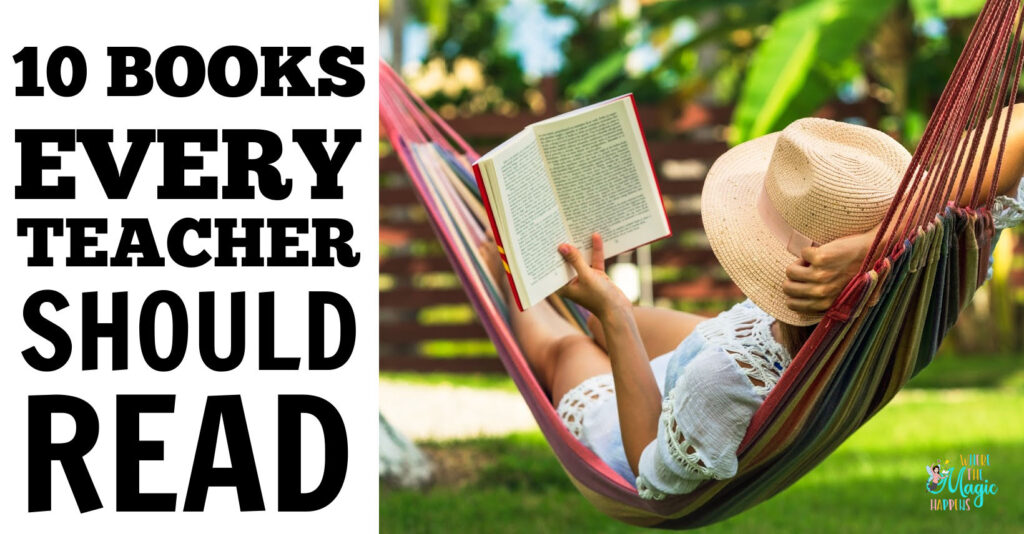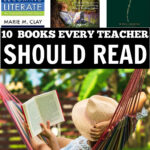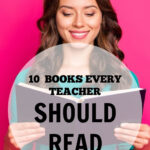In one of those nerdy conversations that primary teachers have occasionally, the question came up about the best books for teachers. I started thinking about the books I have read that influence my classroom teaching. It was easy to start naming books and authors that have influenced me, so I started writing down some titles and authors. The list grew and I kept writing more titles. I even started organizing the titles based on what I learned from them.
Creating the list helped me think about what I believe is important to know about literacy teaching and learning. I am a self-proclaimed constructivist and you will see that in my list. The first five books are what I consider to be essential reads for any primary grade teacher of reading and shaped my instruction in powerful ways. The second five are titles are the current ones from books that have come and go from my list. Some have stayed for a long time and others are new. I have written many times before about books for students, but never about books for teachers.
All represent authors I would read regardless of the book title or attend a session when they were presenting.

Becoming Literate: The Construction of Inner Control by Marie Clay – This book is the
foundation, the theory behind everything that happens in my classroom. It is where I
learned the fundamentals of teaching children to read. I can even quote Clay’s definition
of reading “Reading is the process of constructing meaning through the dynamic
interaction between …” Whenever I read something or hear a speaker I read and listen
through the lens of this book. It is where I learned about what it means to be a
constructivist literacy teacher. If you ask me, this is one of those must-have books for teachers… any teacher!
The Observation Survey of Early Literacy Achievement by Marie Clay – This book is
where I learned about running records and their power to help me understand children’s
thinking as they read. I was also introduced to the Concepts about Print assessment for
kinder and first graders. There are elements of beginning reading that we assume children control. This assessment helped me see that I cannot assume if, where, and how children are looking at print. A great substitute for this book is the versions for classroom teachers about running records and concepts about print called Running Records for Classroom Teachers and Concepts about Print for Classroom Teachers. In order to be an effective classroom teacher, I need some useful and quick assessments to understand my children and these are my two go to assessments.
Guided Reading: Responsive Teaching across the Grades by Irene Fountas and Gay Su
Pinnell or its predecessor Guided Reading: Good First Teaching – These books are
where I learned about the basics of implementing a balanced literacy framework in my
classroom. Fountas and Pinnell take Clay’s theories and put them into practice in the
classroom. This book gives teachers the how and why of the teaching of reading, writing,
and oral language development. Youi will find many references to Clay in these books,
so it is easy to see the connection between theory and practice. We all need the theory to
inform our practice!
Guided Reading: The Next Step Forward by Jan Richardson – This book is great for after
you feel like you have the basics of teaching reading, especially guided reading under
control, but you have more specific questions. Thus the “next step” in the title. It really
focuses on the guided reading portion of the balance literacy framework which is the
heart of classroom teaching for primary grade children. Jan Richardson offers clear
guidance for teachers about the nuances of teaching that helped me become both efficient and effective as a reading teacher. This book, has greatly impacted my small group instruction and has taught me about guided close reads.
Teaching Struggling Readers: How to Use Brain-based Research to Maximize Learning
by Carol Lyons – No matter how good your classroom teaching is, there will still be
children who struggle. This book helped me understand what these children are
experiencing as learners and how to reach them as a classroom teacher. You need to dig
deep in your teacher brain in order to help these children become successful readers and
this book really helps with that kind of analysis. I did not struggle as a reader and writer
myself, but math was a challenge for me. After reading this book, I understood myself as
a learner and so I understand my students better.
The next five books are books to fill in my thinking and enrich my classroom. Books come on and go off this list as I encounter new writers from the constructivist perspective.
Choice Words: How are Language Affects Children’s Learning by Peter Johnson – This
book was on Instructor Magazine’s “must read” list when it first came out. It helped me
understand the power of my own words as teacher. The difference between “and” and
“but” in the messages I send to children is just one example. Calling a child a writer or a
scientist, can offer them an identity they did not know existed for them. Once I have an
identity, I can become that kind of person much more easily. There is a sequel to this
book called Opening Minds: Using Language to Change Lives. I initially read this book when I was completing my master’s program, and our of all the books for teachers that I recommend in this article, THIS ONE is the one that has affected the relationship with my students the most.
Classrooms that Work by Richard Allington and Pat Cunningham – This book gave me a
perspective on schools and classrooms and the difference they can make in the lives of
children. An excellent classroom teacher for two years in a row can set children on a
positive learning trajectory that can last a lifetime. This book really helped me understand
that what I do can make a difference in the life of a child. There are multiple editions of
this book as it is often used in classes at the university level. Allington and Cunningham
have worked to keep the information as new research becomes available.
Word Matters: Teaching Phonics and Spelling in the Reading/Writing Classroom by
Irene Fountas and Gay Su Pinnell – This book put the teaching if phonics into a
perspective that is important to understand when teachers are being pushed to implement
phonics programs as their reading program. Phonics is an important piece of a literacy
program, but it is only a piece. Phonics needs a context for it to be meaningful for
children. There is a companion to this book called Voices on Word Matters that provides
the perspective of others on the role that phonics plays in literacy instruction.
The Reading Strategies Book: Your Everything Guide to Developing Skilled Readers by
Jennifer Serravallo – This book is chock full of goals and teaching strategies to help
achieve broad reading goals and then to develop lessons for children as their reading
needs evolve and change during the school year. Whenever I am look for an idea about
how to teach a mini lesson, I find myself turning to this book. This book is one you will
keep on the corner of your desk or on top of your bookshelf. It is very practical and
useful! The way this book is organized makes in particularly useful. Serravallo has a
companion book called Writing Strategies Book: Your Everything Guide to Developing
Skilled Readers that is every bit as useful for developing writing mini lessons.
Reading in the Wild: The Book Whisperer’s Keys to Cultivating Lifelong Reading Habits
by Donalyn Miller – This book helps me keep a focus on why I am teaching reading in
my classroom. When I am challenged about why I do independent reading in my
classroom, why I want children to choose their own books, why talking about books is
important, I can go to this book to remind myself why reading matters and how I can
instill the love of reading into my classroom environment. It is not enough to let children
read when they finish their work. Becoming a reader is why we do everything we do in
our classrooms toward the teaching of reading.




Leave a Reply